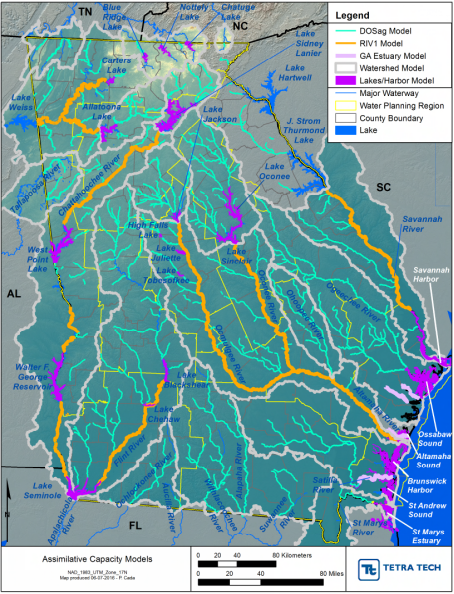
Surface Water Quality
The Surface Water Quality (Assimilative Capacity) resource assessment evaluates the capacity of surface waters to process pollutants, including those in treated wastewater. Each river and lake has a natural ability to absorb and use – or assimilate – a variety of pollutants without harming aquatic life or humans who come in contact with the water. This ability is known as assimilative capacity. However, a water body can be overloaded and violations of water quality standards may result. Water quality standards define the uses of a water body and set pollutant limits to protect those uses. The water quality assessment evaluates the capacity of surface waters to process pollutants without violating water quality standards.
The Surface Water Quality (Assimilative Capacity) resource assessment was undertaken for the first time in 2010 and updated in 2017. This resource assessment included developing water quality models of selected streams, rivers, lakes and estuaries throughout the State of Georgia. Results from these models were compared with applicable water quality standards. The assimilative capacity results focus on dissolved oxygen, nutrients (specifically nitrogen and phosphorus), and chlorophyll a. The water quality models were used to evaluate the impacts of current wastewater and industrial discharges and withdrawals, landuse, and meteorological conditions on the waterbody. For future conditions, assumptions were made regarding future permit limits (including assumed reductions in permit limits), and in general, future condition results show that there is available assimilative capacity in relation to applicable water quality standards.
For the following parameters, the following modeling tools were used in the resource assessment:
Dissolved Oxygen (DO):
- Georgia Dosag (GA Dosag) is a steady state model used to predict dissolved oxygen (DO) concentrations in a stream or river during critical time periods which include low flow and high temperatures.
- Georgia Estuary (GaEst) is a steady state mid-tide model used to predict the dissolved oxygen sag curve in the vicinity of waste discharge points in Georgia estuaries.
- Georgia EPD RIV-1 (EPD RIV-1) is a hydrodynamic water quality model used to predict the DO concentrations in rivers downstream of dams that have highly variable streamflow.
- EFDC models were also used for the Ossabaw, Altamaha, Brunswick Harbor, St. Andrews, and St. Mary's estuaries.
Nutrients (nitrogen, phosphorus) and chlorophyll a:
- The Loading Simulation Program C++ (LSPC) is a watershed model used to simulate both flow and water quality, from nonpoint and point sources in watersheds. LSPC was used to simulate various water quality parameters including temperature, dissolved oxygen, and nutrients.
- The Environmental Fluid Dynamics Code (EFDC) is a hydrodynamic and water quality model used to simulate both flow and water quality in lakes and estuaries. EFDC was used to simulate various water quality parameters including temperature, dissolved oxygen, nutrients, and chlorophyll a.

The summary of results from the Surface Water Quality (Assimilative Capacity) Resource Assessment are presented in the 2017 synopsis report. Additional Appendices to this report provide more detail about:
- The model methodologies and assumptions (Appendix A),
- Dissolved oxygen results (Appendix B), and
- Nutrient results (Appendix C)
Further detailed modeling results, by watershed and including all modeled simulation results (by year) for nutrients and biochemical oxygen demand (BOD5), are presented in Appendices D through W. If you would like to obtain copies of those Appendices, please call Jennifer Welte at (470) 524-0605.